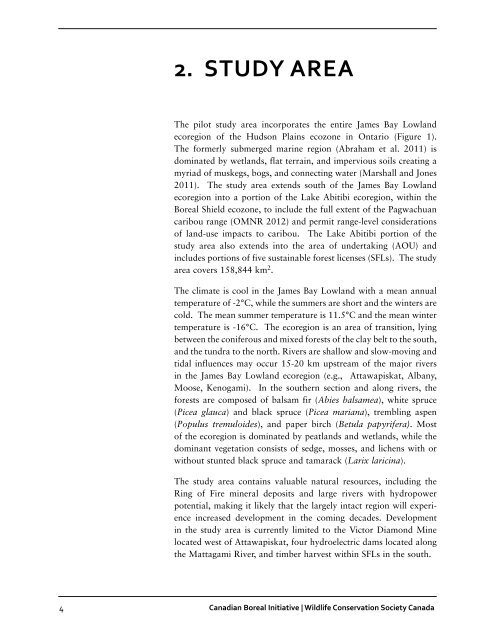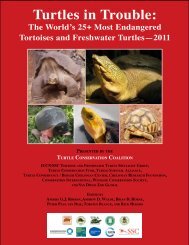Create successful ePaper yourself
Turn your PDF publications into a flip-book with our unique Google optimized e-Paper software.
2. Study Area<br />
The pilot study area incorporates the entire James Bay Lowland<br />
ecoregion of the Hudson Plains ecozone in Ontario (Figure 1).<br />
The formerly submerged marine region (Abraham et al. 2011) is<br />
dominated by wetlands, flat terrain, and impervious soils creating a<br />
myriad of muskegs, bogs, and connecting water (Marshall and Jones<br />
2011). The study area extends south of the James Bay Lowland<br />
ecoregion into a portion of the Lake Abitibi ecoregion, within the<br />
Boreal Shield ecozone, to include the <strong>full</strong> extent of the Pagwachuan<br />
caribou range (OMNR 2012) and permit range-level considerations<br />
of land-use impacts to caribou. The Lake Abitibi portion of the<br />
study area also extends into the area of undertaking (AOU) and<br />
includes portions of five sustainable forest licenses (SFLs). The study<br />
area covers 158,844 km 2 .<br />
The climate is cool in the James Bay Lowland with a mean annual<br />
temperature of -2°C, while the summers are short and the winters are<br />
cold. The mean summer temperature is 11.5°C and the mean winter<br />
temperature is -16°C. The ecoregion is an area of transition, lying<br />
between the coniferous and mixed forests of the clay belt to the south,<br />
and the tundra to the north. Rivers are shallow and slow-moving and<br />
tidal influences may occur 15-20 km upstream of the major rivers<br />
in the James Bay Lowland ecoregion (e.g., Attawapiskat, Albany,<br />
Moose, Kenogami). In the southern section and along rivers, the<br />
forests are composed of balsam fir (Abies balsamea), white spruce<br />
(Picea glauca) and black spruce (Picea mariana), trembling aspen<br />
(Populus tremuloides), and paper birch (Betula papyrifera). Most<br />
of the ecoregion is dominated by peatlands and wetlands, while the<br />
dominant vegetation consists of sedge, mosses, and lichens with or<br />
without stunted black spruce and tamarack (Larix laricina).<br />
The study area contains valuable natural resources, including the<br />
Ring of Fire mineral deposits and large rivers with hydropower<br />
potential, making it likely that the largely intact region will experience<br />
increased development in the coming decades. Development<br />
in the study area is currently limited to the Victor Diamond Mine<br />
located west of Attawapiskat, four hydroelectric dams located along<br />
the Mattagami River, and timber harvest within SFLs in the south.<br />
4 Canadian Boreal Initiative | Wildlife Conservation Society <strong>Canada</strong>







![RaLand / SeaScape [PDF] - Wildlife Conservation Society](https://img.yumpu.com/49974326/1/190x245/raland-seascape-pdf-wildlife-conservation-society.jpg?quality=85)









